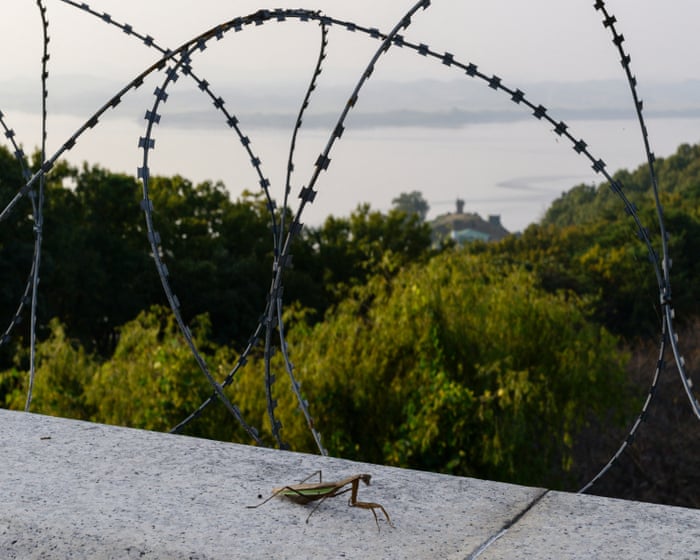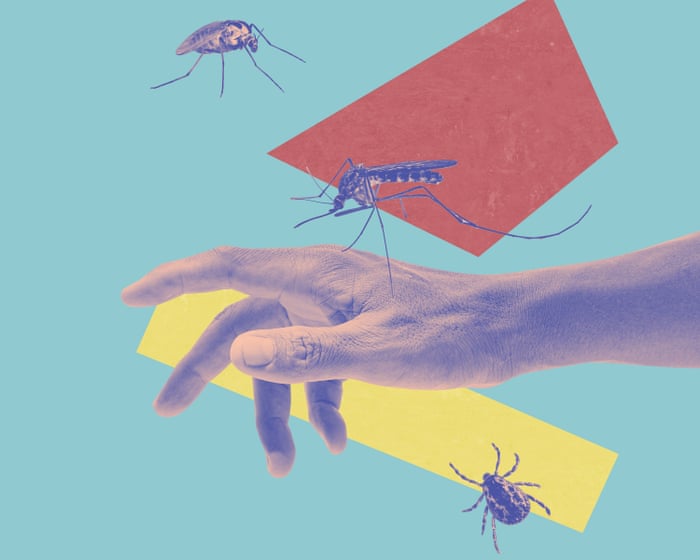Standing atop a small mountain, Kim Seung-ho looks out over a sea of golden paddy fields, the ripening grain swaying softly in the breeze. In the distance, North Korea stretches beyond the horizon.
“It’s so peaceful,” says the director of the DMZ Ecology Research Institute. “That area used to be an artillery range, but since the shelling stopped, nature has reclaimed it beautifully.”
The land before him is the Demilitarized Zone, or DMZ—a strip running across the Korean Peninsula, roughly along the 38th parallel, dividing North and South Korea.
This heavily fortified border was established after the devastating Korean War, which lasted from 1950 to 1953. The conflict ended with an armistice, not a peace treaty, leaving the two countries technically still at war and separated by this buffer zone.
A mantis rests under barbed wire at a viewing point where visitors look across the DMZ toward North Korea.
Stretching 155 miles long and 2.4 miles wide, the DMZ is far from demilitarized. It remains one of the world’s most heavily armed borders, filled with landmines and flanked by military installations on both sides.
Yet, over the 72 years since the war ended, this forbidden strip has unintentionally become an ecological haven.
South Korea’s National Institute of Ecology has recorded nearly 6,000 species here, including more than 100 endangered ones—accounting for over a third of the country’s threatened wildlife.
As Kim Seung-ho notes, “The landmines are doing more for conservation than anyone.”
The varied terrain supports distinct habitats: western wetlands shelter migrating cranes, while the rugged eastern mountains provide refuge for threatened mammals like Siberian musk deer and Asiatic black bears.
Kim and his small team of volunteers, based at their research institute in Paju near the border, have spent two decades documenting this unexpected sanctuary. Every week, rain or shine, they survey the Civilian Control Zone (CCZ), the restricted buffer area next to the DMZ.
“In temperate regions around the world, big cities have taken over,” he says. “There’s nowhere else where nature has been left untouched like this.”
Though the DMZ and surrounding areas cover less than 10% of South Korea’s land, they host 38% of its endangered species and over 30% of its plants and animals. This ecological miracle, however, comes with a dark irony.
“I used to think I was the best environmentalist,” Kim reflects, “but I realized the landmines are doing more for conservation than anyone. It’s ironic, isn’t it? Weapons meant for killing have become the greatest protectors of life.”
Remote cameras have captured images of an Asiatic black bear, raising hopes that this threatened species is breeding in the area.
Kim’s team carefully records every important species they find, building a detailed database of the region’s wildlife. They map each sighting, tracking how species move and habitats change over time. Their thorough documentation has become highly respected.
“At government meetings, researchers sometimes hesitate to speak when we’re there,” Kim says. “They know our data is more complete and accurate than the official records.”
Despite its ecological wealth, researching the DMZ is full of challenges. The zone itself remains off-limits to most civilians, heavily guarded and lined with military installations.
A view over the Civilian Control Zone, the restricted buffer area bordering the DMZ.On the southern side of the DMZ lies the Civilian Control Zone (CCZ), where entry is heavily restricted. Civilians must pass through military checkpoints, obtain special permission from the defence ministry, and in some cases, be accompanied by a military escort.
As we drove toward one of the few crossing points into the DMZ, Kim noted how fortunate we were to have been granted access. “Usually, when tensions are this high, civilian access is the first thing to be cut off,” he said.
Shortly after, we received a call from the defence ministry informing us that our clearance had been revoked due to sudden military activity along the border.
“This is the reality we work in,” Kim sighed as we turned back to survey a nearby non-militarised area instead. “One moment we’re planning research; the next, the military situation shifts, and everything gets put on hold.”
Kim’s team carefully documents every important species they come across, building a detailed database of the region’s wildlife. It was a frustrating setback, but one his team has grown accustomed to. Later, it became clear that North Korean soldiers had approached the demarcation line to plant explosives, destroying the last remaining roads connecting the two Koreas.
This serves as a stark reminder that although hostilities officially ended in 1953, tensions are still very much alive.
These disruptions point to a deeper concern: both war and peace threaten the delicate sanctuary that has developed within the DMZ. Kim worries that any peace agreement could lead to development, endangering the fragile ecosystem.
“The current generation shouldn’t decide the DMZ’s fate,” he argues. “We should leave that to a future generation that truly values biodiversity. They should be the ones to choose its future.”
When tensions rise, Kim finds comfort in watching the rare cranes that migrate across northeast Asia. They pause in the DMZ before continuing on to Siberia for the summer. He hopes that preserving these shared natural treasures might one day help bring the two Koreas closer.
Gazing across the restricted zone, Kim reflects on its significance. “What makes the DMZ special isn’t just its incredible ecology,” he says, watching the majestic birds circle overhead.
“Here, war and peace, life and death exist side by side. The soil holds the remains of soldiers from many nations, yet nature doesn’t distinguish by nationality or ideology. It somehow creates harmony out of these tragic elements.”
Frequently Asked Questions
Frequently Asked Questions
Topic Landmines have become the greatest protectors How wildlife is thriving in the Korean DMZ
BeginnerLevel Questions
Q1 What is the Korean DMZ
A The Korean Demilitarized Zone is a heavily guarded strip of land separating North and South Korea Its about 160 miles long and 25 miles wide established after the Korean War in 1953
Q2 How are landmines protecting wildlife
A Landmines and strict military restrictions have kept humans out of the DMZ for decades This unintended protection has allowed plants and animals to thrive without disturbance
Q3 What kinds of wildlife live in the DMZ
A The area is home to rare species like the redcrowned crane Amur leopard Asiatic black bear and many migratory birds along with diverse plants and insects
Q4 Is it safe for animals with all the landmines
A While landmines pose risks many animal species have adapted and learned to avoid dangerous areas The lack of human activity has overall benefited wildlife populations
Q5 Why is the DMZ called an accidental paradise
A Because its isolationoriginally for military reasonshas unintentionally created a safe haven where nature has rebounded and biodiversity has flourished
AdvancedLevel Questions
Q6 How does the DMZ compare to other protected wildlife areas
A Unlike purposefully conserved parks the DMZs protection is accidental Its unique status offers a rare example of rewilding without human management making it ecologically significant
Q7 What conservation efforts exist for the DMZ
A Scientists and environmental groups advocate for preserving the DMZs ecosystem Some propose turning it into a peace park or UNESCO site though political tensions complicate these efforts
Q8 Are there any downsides to wildlife in the DMZ
A Yes Landmines and unexploded ordnance still harm some animals and pollution from past military use affects soil and water Climate change and habitat fragmentation at the edges are also concerns




